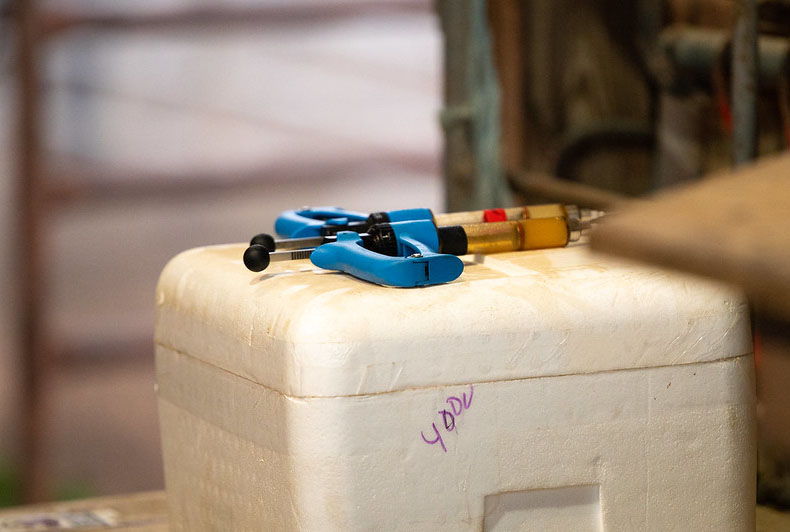
Storing products in a cooler can help keep the medicine out of the direct sun when working cattle. | Download this photo.
Cattle Chat: Product handling and efficacy
K-State beef cattle veterinarians share tips for managing animal health products appropriately
June 27, 2023
By Lisa Moser, K-State Research and Extension news service
MANHATTAN, Kan. — When handling food, people often know to read the label to guide them on how to properly store the product so that the ingredient can be used at its peak and food waste is minimized.
In much the same way, livestock producers need to read the label on animal health products to know how to best store them for optimum performance, according to the veterinarians at the Kansas State University Beef Cattle Institute.
Product storage
“While products that are labeled to be refrigerated need to be maintained in a refrigerator, there are many products out there labeled for room temperature,” said K-State veterinarian Brian Lubbers on a recent Cattle Chat podcast. “The upper limit of room temperature for non-refrigerated drug products is usually considered 85 degrees (Fahrenheit).”
But in a Kansas barn in the summer, those temperatures often creep much higher.
“We know that those summer temperatures can exceed well over 100 degrees, so it is important to use a temperature-controlled location to store products,” Lubbers said. “Heat and extreme cold can change the drug molecules and have a negative impact on the product.”
Along with temperature, sunlight exposure can also be an issue.
“Drug products that are stored in amber bottles are affected by UV radiation and sunlight exposure will diminish the effectiveness of those products,” Lubbers said.
When deciding if a product that has been stored on a shelf for a while is still good, Lubbers said it is important to look at the product consistency.
“Any time there are lumps of material floating in the product, discard it because the product efficacy is likely diminished and in some rare cases the product could be toxic due to chemical changes,” Lubbers said.
If product changes have occurred when handled properly and the product has not passed its expiration date, Lubbers recommends reaching out to the supplier to see about getting a replacement product.
Product handling when processing
At the time of cattle processing, Lubbers said it is important to keep cold storage products at the proper temperature by using coolers and ice packs.
“I’ve seen people punch holes in the top of a Styrofoam cooler where they can drop in the syringes in a cooler with ice packs to help keep the product cool and minimize the number of times the lid is opened,” Lubbers said.
He added that the cooler can also be used to keep products out of the sunlight.
Veterinarian Brad White said that he has seen producers place the product under a towel to keep it out of the sun when not needed during processing.
“With modified-live products, it is especially important to keep them out of the sun,” White said.
Another one of White’s tips is to only mix up the amount of product that is needed.
“When giving shots, I try to only mix up what I need and then place those products in a cooler or under a towel until the next animal comes through,” White said.
To hear the full discussion, listen to the Cattle Chat podcast online or through your preferred streaming platform.

